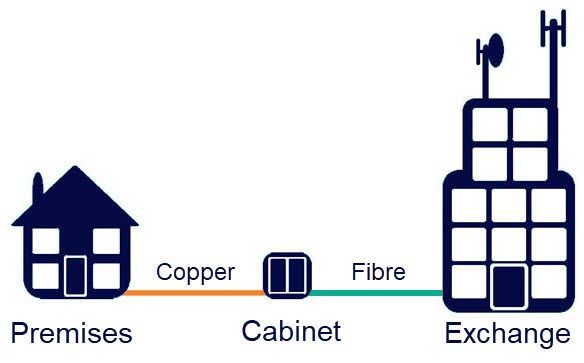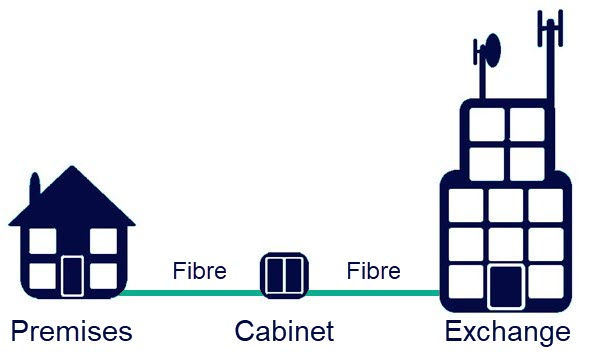Broadband can be a complicated. ADSL, FTTC, FTTP what does it all really mean? Here we will discuss the different broadband types and what that really means for your business. If you are struggling with slow, temperamental broadband we can help.

How are we connected to the internet?
Every home and business is connected to the internet via some sort of cable that links you to a point of exchange. The cables are ultimately made from either copper or optical fibres. Whichever cable is used can have a great impact on the speeds and reliability of broadband that is supplied.
| Copper Cables | Optical Fibre Cables |
Bandwidth | < 1 Gigabit per second | > 10 Gigabits per second |
Distance | 100 m | > 40 Km |
Noise | Susceptible to interference and data surges | No noise |
Durability | Susceptible to corrosion, fragile | High tensile strength |
Security | Susceptible to Tapping | Extremely Difficult to Tap |
Price | £ | £££ |
Copper cables use the same technology as the telephone lines that have been around since the late 1800's! Modern fibre cables on the other hand utilise light sent along thin glass fibres. This method allows for more efficient transfer of data, greater speeds and less interference. Overall, fibre cables are superior for broadband speeds, reliability and security however they are considerably more expensive.
Broadband systems are often comprised of both types of cables and the proportion of each can greatly affect the performance, but what are the different types?
What is ADSL?
ADSL, Asymmetric Digital Subscriber Lines are the slowest available broadband available in the UK. ADSL uses a complete copper system. This means the connection between your home/business to the exchange is limited to a maximum download speed of 8Mbps.

What is ADSL2+?
ADSL2+ is a more modern version of ADSL that uses improved technology allowing for slightly faster speeds. The distance from the cabinet can greatly affect the speeds available for both ADSL and ADSL2+ services. Under optimum conditions ADSL2+ can reach downloads speeds of 24 Mbps.
What is FTTC?
Fibre to the Cabinet, FTTC, is a hybrid system that uses a copper cable between the premises and cabinet but uses optical fibre cables to connect the cabinet to the exchange.

FTTC can provide speeds up to 80 Mbps as more of the infrastructure is comprised from fibre cables. The final connection between the cabinet and premises still uses the copper telephone wires allowing for data transfer and a voice service.
What is FTTC SOGEA?
SOGEA stands for Single Order General Ethernet Access which means that your business can have access to an FTTC connection without the need of an accompanying PSTN telephone line. The FTTC SOGEA line is primarily for broadband which removes any additional telephone line charges.
What is GFAST?
GFAST is another variation of FTTC, that uses slightly different technology within the cabinet, allowing for speeds around 4 times faster. GFAST is only available for limited locations as they need to be within 500m of the cabinet. If available, users can expect download speeds of up to 350Mbps.
What is FTTP?
Fibre to the Premises is a complete fibre system that can provide speeds of up to 1000Mbps. This is the best system for your home or business because it provides a reliable, secure connection between your premises and the exchange. Distance is also not an issue with FTTP as optical cables do not suffer from interference and are extremely reliable over great distances.

What are Leased-Lines?
Leased-Lines use the same technology as FTTP systems but have a service level agreement. For businesses that require as minimal downtime as possible, Leased-lines are the obvious choice. They provide rapid assistance if anything goes wrong. Leased-lines are also an uncontended service whereby you are the only person associated to the line ADSL, FTTC and some FTTP connections will suffer from contention during peak times. This is another important thing to take into consideration when looking at broadband options.
Summary of Service Types:
There are many different broadband types, most of which we have covered in this article. Depending on the proportion of copper cabling to fibre cable can drastically change the available speeds.
Connection Type | Maximum Download Speeds | Upload Speed |
ADSL | 8Mbps | 1.5Mbps |
ADSL2+ | 24Mbps | 1.5Mbps |
FTTC | 80Mbps | 20Mbps |
GFAST | 350Mbps | 100Mbps |
FTTP | 1000Mbps | 100Mbps |
If you are having issues with your current broadband supplier and looking to change then we are here to help. We now offer a range of broadband solutions at discounted pricing to help our clients stay connected. For more information on what we can offer and a free quote please get in touch either through our portal or by giving us a call.

コメント